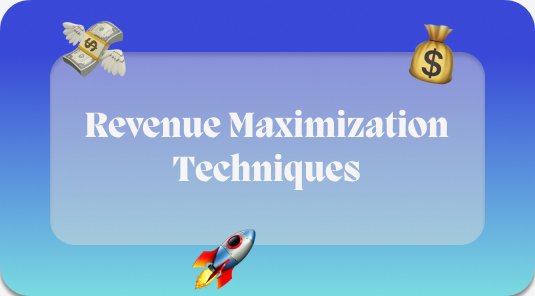Pricing Strategies: A Deep Dive into Revenue Maximization Techniques

Pricing Strategies: A Deep Dive into Revenue Maximization Techniques
Pricing strategies are crucial for businesses aiming to maximize their revenue and position themselves effectively in the market. They encompass a broad range of tactics and approaches that consider various factors including cost, value, customer demand, and competition. The implementation of a robust pricing strategy enables businesses to set optimum prices that not only cover costs and yield a healthy margin but also resonate with their target audience, fostering customer satisfaction and loyalty.

A deep understanding of market dynamics and customer perception is essential in crafting a pricing strategy that works. Businesses must evaluate their competition and their own market position to ascertain how pricing can be used as a tool for growth. Factors like perceived value and psychological pricing come into play, influencing how customers perceive products and services. Additionally, with advancements in technology, businesses now have more data and analytical tools at their disposal than ever before, providing new opportunities for refining pricing strategies.
Key Takeaways
- Effective pricing strategies are tailored to market conditions and customer expectations.
- Techniques like psychological pricing influence how customers perceive value.
- Regular optimization of pricing helps businesses stay competitive and maximize revenue.
Understanding Pricing Strategies
Pricing strategies are critical for businesses aiming to maximize revenue while balancing market forces and production costs. Effective pricing goes beyond mere cost calculations; it requires an understanding of customer behavior, demand, and the ability to adapt to market changes with dynamic models.
The Role of Cost in Pricing
In setting prices, cost-plus pricing offers a straightforward approach. Companies calculate the total cost of producing a product, including materials, labor, and overhead, and then add a set profit margin to determine the selling price. This method guarantees that costs are covered, and a profit is realized on each sale. However, this strategy may not always reflect the perceived value to the customer or competitive pricing pressures.
Assessing Market Demand and Customer Behavior
Pricing is not only a matter of covering costs but also understanding and responding to market demand and customer behavior. When customers perceive a product as valuable, they may be willing to pay more, allowing businesses to command a higher price. Conversely, if demand is low, prices may need to be adjusted to entice customers. Companies that accurately gauge market demand can price products more effectively, aligning their strategy with customers' expectations and willingness to pay.
Dynamic and Flexible Pricing Models
Dynamic pricing is a flexible pricing model that allows businesses to adjust prices on the fly based on real-time market conditions such as changes in demand, inventory levels, or competitor prices. This model offers the advantage of staying competitive and maximizing revenue during different market cycles. On the other end, flexible pricing strategies allow for adjustments based on customer segments, purchasing behavior, and sales contexts, enabling businesses to cater to a broader range of customers and scenarios. Both approaches require a solid foundation in data analytics and an understanding of the market to be executed successfully.
Evaluating Competition and Market Position
When setting prices, businesses must thoroughly understand their competitive landscape and how their market share affects their positioning. This involves analyzing competitor prices and strategies to ensure a company's offering remains attractive to customers while maintaining profitability.
Competitive Pricing Approaches
In the realm of competitive pricing, companies set their product prices based on those set by their competitors. This method can be seen as a response to the market standard, where pricing too high might alienate potential customers, and pricing too low could signify poor quality or lead to unsustainability. Businesses often conduct a competitive price analysis to understand how their competitors price similar products and services.
Key factors include:
- The price range within the market, identifying the upper and lower limits.
- Pricing strategies of direct competitors, determining whether they use loss leaders or premium pricing approaches.
- Market trends that could justify a strategic shift in pricing.
Influence of Market Share and Position on Pricing
A company's market share significantly influences its pricing strategy. The larger a company's market share, the more flexibility it has in setting prices that can sustainably increase revenue. Conversely, a company with a smaller share may need to adhere closer to competition-based pricing to attract and retain clientele.
Considerations include:
- How market position affects perceived value; a leader might command higher prices.
- The impact of competitive pricing on potential market share expansion or contraction.
- The strategic use of pricing to differentiate from competitors and gain a competitive advantage.
By closely evaluating both competitive pricing approaches and the influence of market share, businesses can more effectively price their offerings to reflect their market position and strategic objectives.
Value-Based Strategies for Revenue Growth
Value-based pricing strategies hinge on customers' perceptions of value, which companies leverage to optimize their profitability and growth. This approach involves thorough market research to align price with the anticipated worth of the product or service to the target audience.
Perceived Value and Pricing
At the core of value-based pricing is the perceived value, the customer's assessment of a product's worth compared to its alternatives. Companies that adopt this strategy conduct extensive research to gauge their customers' needs, preferences, and willingness to pay. The key to success lies in understanding that customers evaluate a product's price based on the benefits they expect to receive, which may include not only the product's features but also emotional satisfaction and brand reputation. Therefore, accurate pricing is essential to capture the maximum value from the market, thereby increasing profitability.
Premium Pricing and Brand Perception
Premium pricing is a facet of value-based strategies where businesses set higher prices, which signal superior quality or status to justify the cost. This tactic is often employed by luxury brands, where the high price contributes to a product's allure by enhancing the brand's perception as exclusive or elite. The allure of premium brands is not solely in their material quality but in the cachet they confer upon their customers. For companies, this strategy can lead to greater margins and, by extension, significant growth in revenue as long as the brand consistently meets or exceeds the elevated expectations associated with its positioning.
Psychological Pricing and Customer Perception
Psychological pricing is a pivotal tool in shaping consumer perception and decision-making. It leverages the way customers think and feel about prices, influencing their purchase behavior.
The Impact of Psychological Factors
Psychological pricing strategies are designed to affect the buyer's subconscious, leading to higher sales volumes. One common example is charm pricing, where an item is listed at $9.99 instead of $10, creating the illusion of a bargain. Studies have shown that prices ending in an odd number, such as nine, often generate more sales than their rounded-up counterparts. Factors such as brand name recognition can amplify the effectiveness of psychological pricing, as consumers associate certain prices with quality or value.
Customer loyalty is another aspect impacted by psychological pricing. A consumer's perception that they are getting more value for their money can enhance loyalty to a brand. Conversely, inconsistent pricing may weaken brand loyalty, as customers might feel manipulated if they later discover they could have paid less.
Leveraging Promotions and Discounts
Using promotions and discounts strategically can be a significant revenue booster. For instance, 'Buy One Get One Free' offers can create a sense of urgency and encourage bulk purchases. However, frequent discounts on products may lead to customers waiting for these occasions, thereby reducing their willingness to pay full price and possibly devaluing the brand.
Striking the right balance is key. A promotion on a popular brand name item may enhance perceived value, attracting both new customers and rewarding loyal ones. Special discounts, such as those for subscribers or members, can foster customer loyalty by making them feel part of an exclusive group.
By understanding the complex relationship between psychological pricing and customer perception, businesses can fine-tune their pricing strategies to maximize revenue and build a faithful customer base.
Innovations in Pricing: Technology's Role
The intersection of technology and pricing strategies is transforming how companies optimize revenue. Advanced tools are essential for analyzing data, setting prices, and enhancing customer experiences.
Leveraging Data with Machine Learning
Machine learning (ML) has revolutionized the approach to pricing optimization. By analyzing vast datasets, ML algorithms identify patterns and predict outcomes, such as the price elasticity of products. Companies can then adjust their pricing strategies based on predictive analytics to maximize revenue. For instance, ML can suggest tiered pricing structures by examining customer usage, allowing companies to offer personalized prices.
- Example: A SaaS platform uses ML to analyze user engagement and offer tailored subscription plans, enhancing the perceived value and willingness to pay.
SaaS and Subscription Model Peculiarities
The SaaS industry, known for its subscription models, has unique requirements for pricing innovation. With technology, these businesses can fine-tune models like freemium pricing, where users get basic services for free and are charged for premium features. It encourages upgrades by showing the value of paid tiers.
- Data Tracking: Collects usage statistics to inform which features become paid.
- Engagement Metrics: Determines the conversion rate from free to paid users.
- Pricing Tiers: Offers multiple subscription levels for different user needs.
Boldly, technology equips companies not just with the power to set correct prices but to anticipate and shape consumer behavior.
Tiered and Bundled Pricing Techniques
Innovative pricing models such as tiered and bundle pricing are instrumental in catering to varied customer needs and capitalizing on economies of scale. By understanding and implementing these techniques, companies can enhance their ability to differentiate their offerings and optimize their revenue streams.
Creating Value Tiers for Differentiation
Tiered pricing is a strategic approach to pricing where a company offers its products or services at different price points, creating distinct value propositions at each level. The key is to structure these tiers such that each subsequent tier offers incrementally greater value, justifying a higher price. For example, a SaaS company might offer a basic service tier with essential features, a professional tier with more advanced features, and an enterprise tier that includes all features and premium support. This model encourages customers to self-select the tier that best fits their needs and budget.
- Basic Tier: Essential features, lower price
- Professional Tier: Advanced features, moderate price
- Enterprise Tier: All features, premium support, highest price
Bundle Pricing and Economies of Scale
Bundle pricing takes advantage of economies of scale by selling a set of products or services together at a price that's lower than the sum of purchasing each item separately. This technique often results in a higher markup overall due to increased sales volumes. Retailers might use bundle pricing to encourage customers to purchase slow-moving products with popular items. For example, video game consoles are frequently bundled with games and accessories to provide perceived additional value, which prompts buyers to spend more than they would on just the console.
- Game Console Bundle: Console + Games + Accessories, value price
- Office Suite Bundle: Software + Support + Training, special offer price
In both tiered and bundle pricing techniques, the ultimate goal is to create options that fit different consumer segments, leading to increased consumer surplus and better pricing models for the company. This balancing act requires careful consideration of the cost structure and the perceived value by consumers to ensure that all pricing tiers and bundles offer real value to different kinds of buyers.
Customer-Centric Pricing: Acquisition and Retention
Customer-centric pricing is pivotal in developing strategies for customer acquisition and retention. It entails an individualistic approach aiming at customer lifetime value optimization and satisfaction that supports long-term relationships.
Customer Lifetime Value and Long-Term Relationships
Customer lifetime value (CLV) serves as a centerpiece in customer-centric pricing models. Successful businesses strategize their pricing based on the anticipated long-term revenue generated from a customer rather than solely on the initial sale. This approach not only drives acquisition by making the entry price more attractive but also emphasizes customer satisfaction to foster loyalty. The value a customer brings over time is directly related to the quality and endurance of those customer relationships. By focusing on the customer lifetime value, companies can justify investing in superior customer services that contribute to customer satisfaction and, in turn, retention.
Freemium and Loyalty Program Strategies
Freemium models facilitate the acquisition by offering basic services at no cost, thus lowering the barriers to entry. With a carefully structured premium plan, customers find value in the service or product and are willing to pay for extended features or enhanced services. Simultaneously, loyalty programs add an extra layer of value, incentivizing customers to remain engaged, content, and repeat purchasers. Both strategies are designed to scale customer satisfaction and, consequently, the likelihood of positive customer relationships and retention. While the freemium model is about giving customers a taste, loyalty programs are about rewarding for indulging, thereby establishing robust mechanisms for sustained revenue maximization.
Optimization and Revision of Pricing Strategies
Efficient optimization and meticulous revision of pricing strategies are critical for companies to stay competitive and maximize revenue. They must regularly gauge the market and adjust their prices to meet optimal points for profitability.
Regular Market Research and Adjustments
Regular market research serves as a navigational compass for businesses, guiding them through the ever-changing economic landscape. Through diligent market analysis and customer feedback, companies can identify pricing changes that resonate positively with their target audience. Actively monitoring competitors' pricing can provide critical insights, enabling businesses to stay agile and responsive. This may include implementing:
- A/B testing to compare different pricing structures.
- Demand curves analysis to understand how price adjustments affect sales volume.
Optimal Price Point and Maximizing Revenue
Identifying the optimal price point is a delicate balance between demand and profitability. It must reflect the value perceived by consumers while aligning with the company's financial goals. The use of dynamic pricing optimization models allows for real-time adjustments that can capitalize on market trends and maximize revenues. Key factors to consider include:
- Cost analysis: Ensuring the price covers cost plus a desired margin.
- Price sensitivity: Understanding how changes affect customer purchasing behavior.
Effective pricing strategies are iterative—they require ongoing revisions to ensure they are aligned with business goals and market conditions. Employing robust data analysis and revising pricing accordingly are essential practices for generating the utmost revenue in a competitive marketplace.
Stay up to date with our blog
Dive into our informative and engaging blog posts to stay informed on the latest trends in the Webflow & Shopify world as well on actionable tips to make your website work for you.



Contact us
We're only 1 email, call, message or meeting away. We'd be happy to help with your query. Book in a time on our calendar so we can speak.




